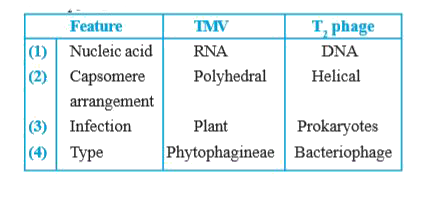A phage is
bacteria to be killed by a virus
virus which kills bacteria/fungi/algae
an association of copy DNA of retrovirus with host chromosome
a stage of division of virus inside host cell
The correct Answer is:B
Step-by-Step Solution:
1. Understanding the Term "Phage":
- A phage, specifically referred to as a bacteriophage, is a type of virus that specifically targets and infects bacteria.
2. Identifying the Function of a Phage:
- The primary function of a bacteriophage is to kill bacteria. It does this by attaching to the bacterial cell and injecting its genetic material into the host.
3. Mechanism of Infection:
- Once the bacteriophage attaches to the bacterial cell, it uses lytic enzymes (also known as lysins) located in its tail region to degrade the bacterial cell wall. This allows the phage to enter the bacterial cell.
4. Replication Inside the Host:
- After the phage has entered the bacterial cell, it can replicate using the bacterial machinery, leading to the production of new phage particles. Eventually, this process results in the lysis (breaking open) of the bacterial cell, releasing new phages to infect other bacteria.
5. Conclusion:
- Based on the information provided, the correct answer to the question "A phage is a" is: "a virus which kills bacteria."
Final Answer:
- A phage is a virus which kills bacteria.
---
- A phage, specifically referred to as a bacteriophage, is a type of virus that specifically targets and infects bacteria.
- The primary function of a bacteriophage is to kill bacteria. It does this by attaching to the bacterial cell and injecting its genetic material into the host.
- Once the bacteriophage attaches to the bacterial cell, it uses lytic enzymes (also known as lysins) located in its tail region to degrade the bacterial cell wall. This allows the phage to enter the bacterial cell.
- After the phage has entered the bacterial cell, it can replicate using the bacterial machinery, leading to the production of new phage particles. Eventually, this process results in the lysis (breaking open) of the bacterial cell, releasing new phages to infect other bacteria.
- Based on the information provided, the correct answer to the question "A phage is a" is: "a virus which kills bacteria."
- A phage is a virus which kills bacteria.
Topper's Solved these Questions
- BOOK - TRUEMEN BIOLOGY ENGLISHCHAPTER - BIODIVERSITT AND CONSERVATIONEXERCISE - MULTIPLE CHOICE QUESTIONS116videos
BIODIVERSITT AND CONSERVATION
- BOOK - TRUEMEN BIOLOGY ENGLISHCHAPTER - BIOTECHNOLOGY : PRINCIPLES AND PROCESSESEXERCISE - MULTIPLE CHOICE QUESTIONS124videos
BIOTECHNOLOGY : PRINCIPLES AND PROCESSES
Similar Questions
Knowledge Check
- Question 1 - Select One
Bacterial artificial chromosomes (BACs), cosmids, phages, plasmids and yeast artifical chromosomes (YACs) are all commonly used cloning vectors that differ in their cloning capacities, with a range from approximately 100 bp to 1000 kb. Which of the following is the correct order for these vectors in terms of increasing cloning capacity ?
ABAC,cosmid,phage,plasmid,YACBYAC,BAC,cosmid,phage,plasmidCPlasmid,phage,cosmid,BAC,YACDPlasmid,cosmid,phage,BAC,YAC
[A] : The Phages which caused lysis of bacterial cell are called virulent phages .
[R] : The viral DNA controls the metabolic machinery of the host cell .View SolutionThe single stranded DNA of phage ϕ×174 has 5400 nucleotides. If average protein contains 200 amino acids, how many different proteins could this phage DNA code?
View SolutionBacterial transduction is phage mediated genetic transfer and was discovered in salmonella by
View SolutionWhich one does not occur in lytic life cycle of a virulent DNA phage?
View SolutionWhich of the following features is incorrect w.r.t TMV and T2 phage ?
 View Solution
View SolutionSometimes, DNA brought by the phage does not integrate with the genome of the recipient bacterium and is lost after one or two generations such genetic recombination is called
View SolutionWhich of the following types of bacteria were used in Griffth's transformation experiment?
(a) Dipolcoccus R-III and S - II type
(b) Pneumcoccus ,T2 phage
(c) Streptococcus, R- II and S- III types
(d) Diplococcus, E.coilView Solution

